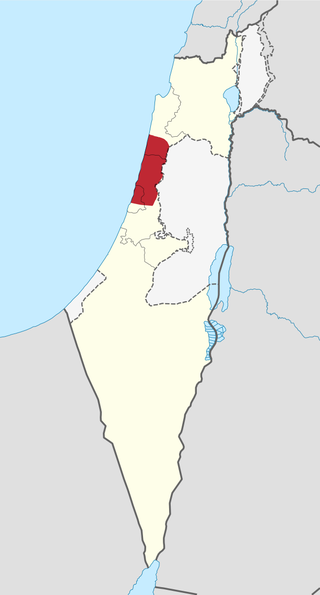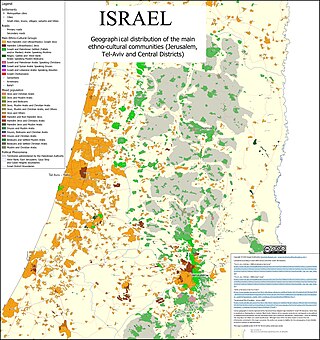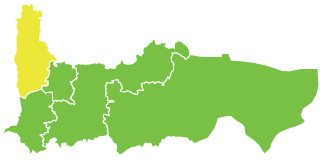
The Sharon plain is the central section of the Israeli coastal plain. The plain lies between the Mediterranean Sea to the west and the Samarian Hills, 15 km (9.3 mi) to the east. It stretches from Nahal Taninim, a stream marking the southern end of Mount Carmel in the north, to the Yarkon River in the south, at the northern limit of Tel Aviv, over a total of about 90 km (56 mi). The level of the Sharon plain is connected to the level of the Mediterranean Sea by the Sharon Escarpment.

The Northern District is one of Israel's six administrative districts. The Northern District has a land area of 3,324 km2, making it the second largest district in Israel. The district capital is Nof HaGalil and the largest city is Nazareth.

Haifa District is an administrative district surrounding the city of Haifa, Israel. The district is one of the seven administrative districts of Israel, and its capital is Haifa. The district land area is 864 km2 (299.3 mi2).

The Tel Aviv District is the geographically smallest yet also the most densely populated of the six administrative districts of Israel, with a population of 1.35 million residents. It is 98.9% Jewish and 1.10% Arab.

There are six main administrative districts of Israel, known in Hebrew as mekhozot and in Arabic as mintaqah. There are also 15 subdistricts of Israel, known in Hebrew nafot and in Arabic as qadaa. Each subdistrict is further divided into natural regions, which in turn are further divided into council-level divisions: whether they might be cities, municipalities, or regional councils.

Al-Suqaylabiyah District is a district (mantiqah) administratively belonging to Hama Governorate, Syria. At the 2004 official census, the district had a population of 240,091. Its administrative centre is the city of Al-Suqaylabiyah. The district includes most of Al-Ghab plain.

Masyaf District is a district (mantiqah) administratively belonging to Hama Governorate, Syria. At the 2004 Census it had a population of 169,341. Its administrative centre is the city of Masyaf.

Hama District is a district (mantiqah) administratively belonging to Hama Governorate, Syria. At the time of the 2023 Census, it had a population of 1,054,000 Its administrative centre is the city of Hama.

The Jerusalem Subdistrict was one of the subdistricts of Mandatory Palestine. It was located in and around the city of Jerusalem. After the 1948 Arab–Israeli War, on the Israeli side of the Green Line, the district was integrated into the Jerusalem District. On the other side, the West Bank was annexed into Jordan, the subdistrict was merged with Ramallah Subdistrict to form Jerusalem Governorate, one of three Jordanian governorates in the West Bank.
The Acre Subdistrict was one of the subdistricts of Mandatory Palestine. It was located in what is now northern Israel, having nearly the same territory as the modern-day Acre County. The city of Acre was the district's capital.
The Safed subdistrict is one of Israel's sub-districts in the Northern District. As the name suggests, the main settlement is the town of Safed.
The Jezreel subdistrict is one of Israel's sub-districts in Northern District.
The Acre Subdistrict, alternatively spelt as Akko Subdistrict or Akka Subdistrict, is one of Israel's sub-districts in the Northern District.
The Golan Subdistrict is an area administered by Israel as a subdistrict of Northern District. The subdistrict encompasses the Israeli-occupied territories of the Golan Heights, occupied from Syria during the 1967 Six-Day War and annexed to Israel under the Golan Heights Law. Thus, this region is internationally seen as Syrian territory, encompassing parts of the Syrian Quneitra Governorate.
The HaSharon Subdistrict is one of Israel's subdistricts in the Central District. The principal city of this subdistrict is Netanya. The subdistrict is situated in the Sharon plain, a section of Israel's coastal plain, from which it draws its name.
The Petah Tikva Subdistrict is one of Israel's subdistricts in the Central District. The principal city of this subdistrict, as the name implies, is Petah Tikva.
The Rehovot subdistrict is one of Israel's subdistricts in Central District. The principal city of the subdistrict is, as the name implies, Rehovot.
The Ramla subdistrict is one of Israel's subdistricts in the Central District. There are three principal cities in the subdistrict: Ramla, Lod, and Modi'in-Maccabim-Re'ut.
The Ashkelon Subdistrict is the northern of the two sub-districts in Israel's Southern District. Its population is more than half a million. It is an important region for manufacturing including electricity production and water desalination, agriculture, transportation, tourism, and trade.
The Beersheba Subdistrict is the southernmost subdistrict of Israel and one of two subdistricts in its Southern District. The capital of the subdistrict is, as the name implies, Beersheba. Rahat is the second-largest city and Eilat comes third. Other cities in the subdistrict are Arad, Dimona, Netivot, and Ofakim. Hura and Kseifa have not received city status yet are of similar size. The subdistrict includes an international airport, near Eilat, and a seaport in Eilat.









